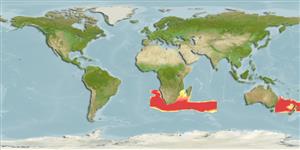>
Lophiiformes (Anglerfishes) >
Oneirodidae (Dreamers)
Etymology: Oneirodes: Greek, 'oneiros' = a dream or dreamlike or out of a dream (suggesting this fish is so strange and marvelous that can exist only in dreams) (Ref. 86949).
Environment: milieu / climate zone / depth range / distribution range
Ökologie
seewasser bathypelagisch; tiefenbereich 0 - 2000 m (Ref. 10977), usually ? - 1000 m (Ref. 86949). Deep-water; 18°S - 45°S, 0°E - 180°E (Ref. 86949)
Circumglobal, southern latitudes of SE Atlantic, Indian and Western Pacific ocean; northernmost record off Port Hedland, Western Australia , at about 18°S; southernmost record on the Pacific side of the South I. of New Zealand, about 45°S.
Size / Gewicht / Alter
Maturity: Lm ? range ? - ? cm
Max length : 11.1 cm SL Männchen/unbestimmt; (Ref. 58502); common length : 2.0 cm TL Männchen/unbestimmt; (Ref. 10977); common length :7.5 cm TL (female)
Kurzbeschreibung
Morphologie | Morphometrie
Rückenflossenstacheln (insgesamt): 1; Rückenflossenweichstrahlen (insgesamt): 5-6; Afterflossenstacheln 0; Afterflossenweichstrahlen: 4. Characterized by having escal morphology: pair of highly branched medial escal appendages, in combination with an elongate cylindrical lateral escal appendage on each side; well-developed lateral escal appendage; esca with a pair of stout, medial appendages; more globose form, having a deeper and longer head and a longer lower jaw than O.anisacanthus; short subopercle, dorsal end rounded or tapering to a point, without indentation on posterodorsal margin; length of ventral fork of opercle 28.6-31.9% SL; ratio of lengths of dorsal and ventral forks of opercle 0.47-0.53; absence of epibranchial teeth; presence of teeth on pharyngobranchial II; upper jaw teeth 16-55; lower jaw teeth 24-50; teeth on vomer 4-8; dorsal fin rays 5-6; anal fin rays 4; pectoral fin rays 16-18; head length 38.6-64.3% SL; head depth 43.9-50.5% SL; length of premaxilla 30.7-35.5% SL; length of lower jaw 45.5-52.3% SL; illicial length 22.3-27.3% SL (Ref. 86949).
Mesopelagic species (Ref. 7300, 75154). Most specimens taken in depths less than 1000 m with bottom trawls (Ref. 86949). Maximum depth reported in Ref. 10977. No male specimens are known.
Life cycle and mating behavior
Geschlechtsreife | Fortpflanzung | Ablaichen | Eier | Fecundity | Larven
Pietsch, T.W., 1986. Oneirodidae. p. 375. In M.M. Smith and P.C. Heemstra (eds.) Smith's sea fishes. Springer-Verlag, Berlin. (Ref. 10977)
IUCN Rote Liste Status (Ref. 130435)
Bedrohung für Menschen
Harmless
Nutzung durch Menschen
Fischereien: nicht kommerziell
Mehr Information
NamenSynonymeMetabolismusRäuberÖkotoxikologieFortpflanzungGeschlechtsreifeAblaichenSpawning aggregationFecundityEierEientwicklung
Alter/GrößeWachstumLänge-GewichtLänge-LängeLängenhäufigkeitenMorphometrieMorphologieLarvenLarven Pop.Dyn.RekrutierungDichteBRUVS
ReferenzenAquakulturAquakultur ProfilZuchtlinienGenetikElectrophoresesVererbbarkeitKrankheitenVerarbeitungNutrientsMass conversion
PartnerBilderStamps, Coins Misc.LauteCiguateraGeschwindigkeitSchwimmstilKiemenoberflächeOtolithsGehirngrößeSehfähigkeit
Tools
Zusatzinformationen
Download XML
Internet Quellen
Estimates based on models
Preferred temperature (Ref.
123201): 5.2 - 12.9, mean 7.9 °C (based on 145 cells).
Phylogenetic diversity index (Ref.
82804): PD
50 = 0.5000 [Uniqueness, from 0.5 = low to 2.0 = high].
Bayesian length-weight: a=0.01995 (0.00906 - 0.04395), b=3.01 (2.83 - 3.19), in cm total length, based on all LWR estimates for this body shape (Ref.
93245).
Trophic level (Ref.
69278): 4.0 ±0.7 se; based on size and trophs of closest relatives
Widerstandsfähigkeit (Ref.
120179): mittel, Verdopplung der Population dauert 1,4 - 4,4 Jahre. (Preliminary K or Fecundity.).
Fishing Vulnerability (Ref.
59153): Low vulnerability (10 of 100).
